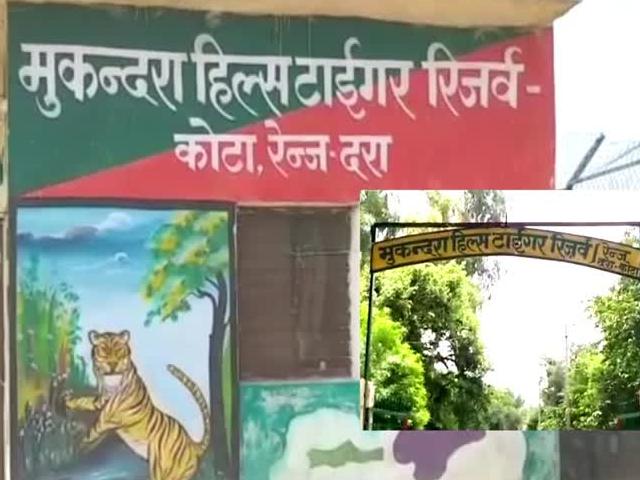Adventures of Oban
Oban and Asha, a female, were released in the open forest of Kuno on March 11 marking the final defined step of translocation from Namibia to India. The duo along with six more were airlifted from Namibia to India on September 17 last year. For months they were first kept in quarantine and then to a bigger enclosure before releasing them in the open forest. Few days later two more males- Elton and Freddie too were released. Within days, Asha and Oban moved out of the small park which has an area of about 749 sq kms. Oban was moving in the territorial forest soon after his release but there was no evidence to report the issue. The first evidence came through a video shot by a villager while Oban was spotted under stressed conditions in a farm field . The villagers spotted him in onion and wheat fields. On April 2 they said on camera , “ we have been spotting the cheetah for the last 11 but today ( April 2) , the animal was moving too close to our dwellings. The cheetah has also killed two cows.” Panic stricken villagers also allegedly pelted stones at the animal.
Also read: Cheetah Escapes From Kuno , Scares Villagers
The animal was monitored almost round the clock by a team of about 10 officials .When Oban was spotted, he looked under stress and frightened, officials said. Tracking the cheetah through satellite collar signals , the team members persuaded the animal to go back to Kuno as they yelled, “Oban go back, Oban come” . The same evening they succeeded as the cheetah was chased back to Kuno Park but the very next day he again went missing. Ultimately on April 6, the cheetah was tranquilized from a hamlet in Bairad village of Shivpuri district. A hillock separates the jungle of Kuno and the village on the other side. Cheetah must have travelled almost 25 kms more after leaving behind the park boundaries.
Task Before Cheetah Task Force
Park authorities claimed that all the three remaining cheetahs continue to remain inside the Kuno’s boundaries, except on some occasions when Asha escaped only to return soon. But why does Oban continue to move out? Is it lack of prey? The villagers have already claimed that Oban had killed two cows also. Or something else is attracting the animal. His behavior is baffling the officials of the Cheetah Task Force (CTF), headless since its constitution and now also lacks expert opinion in the absence of YV Jhala, former dean of the Wildlife Institute of India (WII). One cheetah expert feels, “tranquilization is stressful for any animal.” But others said, “its safety of animals which is paramount.” Oban was roaming around villages.
Also read: More Questions On Cheetah Project in Kuno
“Any animal outside the protected area becomes unsafe. Villagers or poachers may harm the animal any time. Even crossing barbed wire while chasing a prey would have injured the cheetah”, an official explained. Post-release, cheetahs are known to show lots of movement in the exploration of their new environment, so this situation is not unexpected,Eli Walker cheetah expert writes in a Cheetah Conservation Fund (CCF) blog. As an exercise to ensure safety of the cheetahs, the park authorities have been in touch with the authorities- territorial DFOs (divisional Forest Officials) ,district collectors, SPs, Panchayat CEOs and other officials- of the neighbouring districts of Rajasthan and Madhya Pradesh. “ We also need to develop the 4000 sq km area spread in MP and Rajasthan around Kuno as a cheetah landscape”, an official said. Even the Prime Minister Modi had talked about the animals’ translocation in all the historical cheetah range. So, he said, we need to figure out the second home as soon as possible. When one cheetah could create so much of a scene, what would happen when the remaining 15 are allowed to roam freely in Kuno. Grass lands will not be restored in India just by releasing all the cheetahs in one jungle. According to the action plan, 8 to 10 cheetahs would be translocated from Africa every year for the coming 10 years. Politics Before Conservation ?
Politics Before Conservation ?
Three females from Namibia are waiting to be released in the wild. Besides, all the 12 cheetahs brought from South Africa are still in quarantine in Kuno. According to the Cheetah Action Plan, the government should have started looking for another cheetah home. For this, Mukundara hills tiger reserve in Rajasthan is already ready. Though the state government has given green signal for the cheetahs , the centre is not willing to shift cheetahs to Mukundura. The action plan also said that more cheetah populations are required to be developed. The idea was to develop 3 to 5 separate cheetah populations. Kuno by itself is not viable for the long-term as the site is not big enough to have a viable population.
Also read: As You Watch The Elephant Whisperer, Let's Learn The Plight Of The Pachyderm
One of the authors of the cheetah action plan and former dean of WII YV Jhala said that the work has been slow in establishing other populations. The other parks identified for the project cheetah were Gandhi Sagar sanctuary spread across Mandsaur, Neemuch (both in MP) and Chittorgarh (Rajasthan) and Nauradehi sanctuary situated in Damoh and Sagar districts of Madhya Pradesh . But they need to be developed in terms of village rehabilitation, ecological and prey base restoration requiring Rs 300 crore to Rs 400 crore each. Mukundura is already ready, but the centre is not willing to shift cheetahs in this Rajasthan jungle. It is believed that cheetah conservation has taken back seat while considering Mukundura of Rajasthan, the state going to polls later this year.
By Deshdeep Saxena
Representational Images: Cover Image sourced from Cheetah Conservation Fund





Comments
Post a Comment